
Silent Hunter is a World War II submarine combat simulation for MS-DOS, developed by Aeon Electronic Entertainment and published by Strategic Simulations in 1996. The game takes place in the Pacific War during World War II, the player commanding a submarine of the United States Navy. Most contemporary US submarines and Japanese warships are featured along with some generic merchant ships.
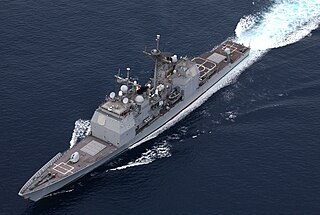
The Aegis Combat System is an American integrated naval weapons system developed by the Missile and Surface Radar Division of RCA, and it is now produced by Lockheed Martin.
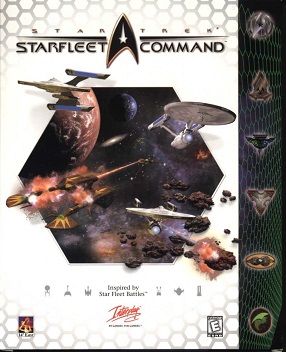
Star Trek: Starfleet Command is a computer game based on the table-top wargame Star Fleet Battles. It was developed by 14° East and Quicksilver Software and published by Interplay Entertainment. It was released in 1999 for Microsoft Windows. It simulates starship operations, ship-to-ship combat, and fleet warfare in the Star Trek universe. An expanded version was released in 2000 titled Star Trek: Starfleet Command - Gold Edition. It includes the latest patch and all the missions that were downloadable from the official website.

Military Sealift Command (MSC) is an organization that controls the replenishment and military transport ships of the United States Navy. Military Sealift Command has the responsibility for providing sealift and ocean transportation for all US military services as well as for other government agencies. It first came into existence on 9 July 1949 when the Military Sea Transportation Service (MSTS) became solely responsible for the Department of Defense's ocean transport needs. The MSTS was renamed the Military Sealift Command in 1970.

The Ticonderoga class of guided-missile cruisers is a class of warships in the United States Navy, first ordered and authorized in the 1978 fiscal year. The class uses passive phased-array radar and was originally planned as a class of destroyers. However, the increased combat capability offered by the Aegis Combat System and the AN/SPY-1 radar system, together with the capability of operating as a flagship, were used to justify the change of the classification from DDG to CG shortly before the keels were laid down for Ticonderoga and Yorktown.

Star Trek is a text-based strategy video game based on the Star Trek television series (1966–69) and originally released in 1971. In the game, the player commands the USS Enterprise on a mission to hunt down and destroy an invading fleet of Klingon warships. The player travels through the 64 quadrants of the galaxy to attack enemy ships with phasers and photon torpedoes in turn-based battles and refuel at starbases. The goal is to eliminate all enemies within a random time limit.

I-War is a space combat simulator developed by Particle Systems and published by Infogrames. The game was first published in November 1997 in Europe, and in late August of 1998 in North America.

Carrier Command is a 1988 video game published by Rainbird for the Amiga, Atari ST, IBM PC compatibles, ZX Spectrum, Macintosh, Commodore 64, and Amstrad CPC. Carrier Command is a cross between a vehicle simulation game and a real-time strategy game where players control a robotic aircraft carrier.

Homeworld is a real-time strategy video game developed by Relic Entertainment and published by Sierra Studios on September 28, 1999, for Microsoft Windows. Set in space, the science fiction game follows the Kushan exiles of the planet Kharak after their home planet is destroyed by the Taiidan Empire in retaliation for developing hyperspace jump technology. The survivors journey with their spacecraft-constructing mothership to reclaim their ancient homeworld of Hiigara from the Taiidan, encountering a variety of pirates, mercenaries, traders, and rebels along the way. In each of the game's levels, the player gathers resources, builds a fleet, and uses it to destroy enemy ships and accomplish mission objectives. The player's fleet carries over between levels, and can travel in a fully three-dimensional space within each level rather than being limited to a two-dimensional plane.

Wing Commander is the first game in Chris Roberts' space flight simulation Wing Commander franchise by Origin Systems. The game was first released for MS-DOS on September 26, 1990 and was later ported to the Amiga, CD32 (256-color), Sega CD and the Super Nintendo Entertainment System, and re-released for the PC as Wing Commander I in 1994. An enhanced remake Super Wing Commander was made for the 3DO in 1994, and later ported to the Macintosh.

Wolfpack is a World War II submarine simulator published by Broderbund in the 1990s, for Amiga, Atari ST, DOS, and Macintosh. It simulates combat actions between wolf packs of German U-boats and convoys of Allied destroyers and merchant vessels in the Battle of the Atlantic.

Strike Fleet is a 1988 video game developed by Lucasfilm Games and published by Electronic Arts. It was released for the Amiga, Apple II, Atari ST, Commodore 64, and MS-DOS. Strike Fleet is the unofficial sequel to the war game PHM: Pegasus.
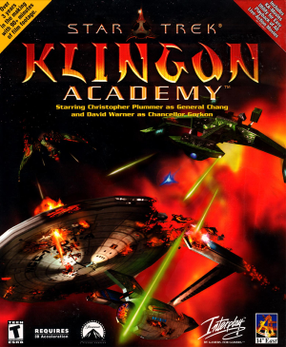
Star Trek: Klingon Academy is a space flight simulator video game developed by 14 Degrees East, an internal development house of publisher Interplay Entertainment. The game follows a young Klingon warrior named Torlek as he attends the Elite Command Academy, a war college created by General Chang to prepare warriors for a future conflict with the United Federation of Planets. Christopher Plummer and David Warner reprised their respective roles as Chang and Gorkon for the production of Klingon Academy.

Fleet Command, previously labelled as Jane's Fleet Command, is a real-time tactics naval warfare simulation computer game released in May 1999. It was developed by Sonalysts Inc. and published by Electronic Arts (EA). The game licensed parts of Jane's Information Group's military information database, which was used as an in-game "Jane's Library", reference material that the player could refer to while in-game. Jane's also licensed to EA the "Jane's" name and the "Jane's Combat Simulations" logo, and the game was marketed under the "Jane's" name, much like the previous "Jane's Fighters Anthology", also published by Electronic Arts.
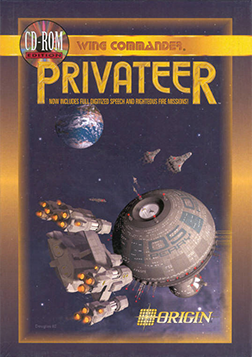
Wing Commander: Privateer is an adventure space trading and combat simulator computer game released by Origin Systems in September 1993. Privateer and its storyline is part of the Wing Commander series. The player takes the role of Grayson Burrows, a "privateer" who travels through the Gemini Sector, one of many sectors in the Wing Commander universe. Unlike Wing Commander, the player is no longer a navy pilot, but a freelancer who can choose to be a pirate, a merchant, a mercenary or any of the above in some combination. The player may follow the built-in plot but is free to adventure on his own, even after the plot has been completed.

Mission Critical is a sci-fi adventure game, created by Legend Entertainment for MS-DOS, written by the company's CEO Mike Verdu, and released in November 1995. The game consists of 3D graphics and features live-action scenes, with the cast including Michael Dorn and Patricia Charbonneau. The games storyline focuses on the player taking on the role of a single crew member, who is left behind on their ship after their captain feigns a surrender to ensure a vital mission can continue. The player's goal focuses on repairing their ship after a recent battle, and then getting to the surface of a planet to complete a secret scientific mission that could provide the means to ending a war over technological advancements and artificial life.

Star Wars: TIE Fighter is a 1994 Star Wars space flight simulator and space combat video game, a sequel in the Star Wars: X-Wing series. It places the player in the role of an Imperial starfighter pilot during events that occur between The Empire Strikes Back and Return of the Jedi.
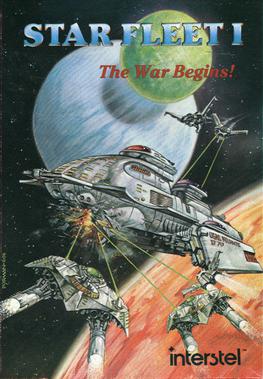
Starfleet I: The War Begins is a 1984 strategy computer game designed by Trevor Sorensen and developed by Interstel. It was released for Apple II, DOS and Commodore 64. Versions for the Commodore 128, Atari ST and Atari 8-bit family were released in 1986 and versions for the Amiga and Macintosh were released in 1987. The game was successful enough to spawn sequels which are collectively known as the Star Fleet series.

PHM Pegasus is a ship simulation and action game released for the Commodore 64, Apple II, DOS, Amstrad CPC, and ZX Spectrum. The title refers to USS Pegasus (PHM-1), one of the Pegasus-class hydrofoils which were used by the U.S. Navy in the 1970s.



















